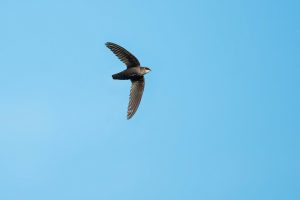If you’ve looked up and saw a flying gray smudge flying around, then you have most likely seen a chimney swift. This little bird is commonly found in the eastern part of the United States.
Early in our history, chimney swifts nested in hollow trees. As the country became more populated, trees were cleared to make room for residential areas. The new homes were built with brick and mortar. With the rise of stone and mortar chimneys, and chimney swifts began to find home and nest in people’s chimneys. Chimneys are a warm place for them to live and nest, and it’s also a safe place to avoid the elements and predators.
Why A Chimney is Perfect

Issues Chimney Swifts Face
Chimney swifts are slowly decreasing. This is because modern chimneys often have metal chimney liners, which are difficult for chimney swifts to cling to. Chimney swifts are protected by the Migratory Bird Treaty Act of 1918, which makes it illegal to knowingly destroy these birds and their egg-bearing nests. Because of the increasing scarcity of theses birds, some homeowners are even allowing chimney swifts to nest in their chimneys.
Chimney swifts build their nests by gathering twigs and leaves to glue them to the walls of the chimney using their saliva. These nests are small, which means that when these birds leave, the nests won’t be a fire hazard.
Chimney Cap
If you don’t want to worry about swifts in your chimney, give Old Dominion Chimneys a call now at 540-434-0888 to make sure that your chimney cap is in good condition. However, if these birds are already nesting in your chimney, they can’t be moved. We’ll wait until the babies are out to remove the nest and fix up your chimney cap, and we will make sure the chimney cap is in good working condition to prevent chimney swifts from entering your chimney ever again.

Recent Comments